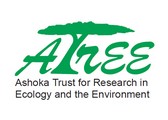Any and all opinions expressed in this newsletter are solely those of the author(s) and do not reflect the opinion of ATREE.
Centre for Excellence in Conservation Science
Royal Enclave,Srirampura,Jakkur Post
Bangalore-560064
Telephone: 080-23635555 (EPABX)
Fax : 080- 23530070
Linneaus, in 1756, termed amphibians as foul and loathsome animals. It is not surprising if many others of the present generation share the same feelings towards amphibians for they are moist, cold and slippery. They were the first four legged vertebrates to have set foot on land and have lived on ever since. Their unique life cycle of having tadpoles in water and adults living in a terrestrial environment is intriguing and are truly among the many hallmarks of evolution. Amphibians comprise frogs and toads, worm-like Caecelians and Salamanders. All the three have been successful in occupying diverse habitats. Far from being loathsome creatures, they provide vital ecosystem services like pest control as they consume large amounts of insects and are also eaten by a variety of animals ranging from mammals, birds to reptiles and are good indicators of a healthy ecosystem. But, with increasing changes to their habitat, pesticide use, fragmentation and alteration of the environment, their survival is at stake. Amphibian populations, world over are in decline and more and more of them are facing the threat of extinction.
India is home to 314 amphibians of which 279 are either frogs or toads. Many more are still being described by scientists while many others are facing the threat of being wiped out. In spite of such great diversity and reported declines elsewhere, we neither have long term population trends nor even basic information on the species-level presence or absence. To bridge such gap, a long term study has been initiated in the evergreen forests of KMTR. The study, unique in many ways, will use the vocalizing behavior of frogs and toads to detect their presence or absence over time and across habitat. To take it a step further, the species adapted to the tall forest canopies are also being documented by accessing the canopies.
Automated sound and data loggers programmed to record at particular intervals have been set up inside forests. They record the orchestra of calling frogs and toads from considerable distances and help detect their presence and activity patterns. This, coupled with manual searches has, so far, resulted in finding 12 species. Five of them have been matched with their calls. The remaining calls are still a mystery but we are at it and should soon know who are these elusive croakers. The calling pattern is studied with respect to environmental variables such as temperature and humidity using automated weather trackers. Done over seasons and years, this data can help us understand the trends and relationships of calling amphibians with the environment. This will have immense potential in the future, to understand the impacts of climate change, pesticide use, disease and others on frog populations. Such signals (data) will indicate the first flash of danger to the ecosystem.
&
nbsp;
Editorial Team
Editor: Allwin Jesudasan
Associate editor: Rajkamal Goswami
Editorial Review: R. Ganesan, M. Soubadra Devy, T. Ganesh
Design and presentation: Kiran Salegame
A S H O K A T R U S T F O R R E S E A R C H I N E C O L O G Y A N D T H E E
N V I R O N M E N T
Eavesdropping on the wild: Monitoring frogs and toads in KMTR
-T. Seshadri K. S.
If you have any suggestions or comments please let us know through the boxes below






